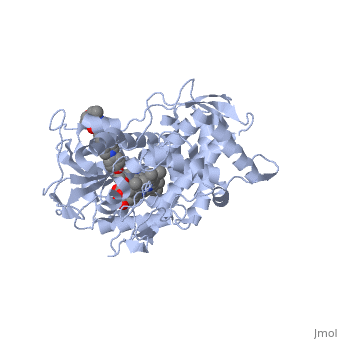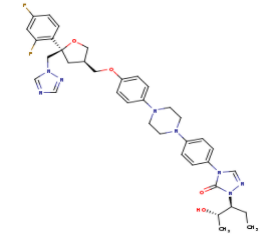Noxafil
From Proteopedia
(Difference between revisions)
| (2 intermediate revisions not shown.) | |||
| Line 1: | Line 1: | ||
| - | <StructureSection load='5FSA' size='350' side='right' caption='PDB ID: | + | <StructureSection load='5FSA' size='350' side='right' caption='Cyp51 complex with pozaconazole (PDB ID: [[5fsa]]' scene=''> |
==Introduction== | ==Introduction== | ||
| - | Noxafil, also known as posaconazole, was developed by Schering-Plough in the mid-2000s <ref name="acs">Posaconazole. (2011, December 12). Retrieved from https://www.acs.org/content/acs/en/molecule-of-the-week/archive/p/molecule-of-the-week-posaconazole.html?_ga=1.240614083.1136742914.1490798730 </ref>. It is a broad spectrum antifungal drug mainly used to treat fungal infections caused by ''Candida'' and ''Aspergillus'' species and derived from a similar triazole antifungal agent, Itraconazole. It is especially effective against filamentous fungi. Noxafil is also often used when other antifungal medicines are not able to be tolerated or if the patient is immunocompromised. Noxafil falls under the triazole class of antifungal drugs and thus works through inhibiting the biosynthesis of ergosterol in the fungal cell membrane, an essential factor that if inhibited, will lead to prevention of cell growth and ultimately death <ref name=pubchem>National Center for Biotechnology Information. PubChem Compound Database; CID=468595, https://pubchem.ncbi.nlm.nih.gov/compound/468595</ref>. It was seen that in a group of patients undergoing chemotherapy or stem cell transplantation, posaconazole was the most effective at the prevention and elimination of invasive fungal infections when compared to alternative treatment options <ref> DOI: 10.1056/NEJMoa061094 </ref>. | + | '''Noxafil''', also known as '''posaconazole''', was developed by Schering-Plough in the mid-2000s <ref name="acs">Posaconazole. (2011, December 12). Retrieved from https://www.acs.org/content/acs/en/molecule-of-the-week/archive/p/molecule-of-the-week-posaconazole.html?_ga=1.240614083.1136742914.1490798730 </ref>. It is a broad spectrum antifungal drug mainly used to treat fungal infections caused by ''Candida'' and ''Aspergillus'' species and derived from a similar triazole antifungal agent, Itraconazole. It is especially effective against filamentous fungi. Noxafil is also often used when other antifungal medicines are not able to be tolerated or if the patient is immunocompromised. Noxafil falls under the triazole class of antifungal drugs and thus works through inhibiting the biosynthesis of ergosterol in the fungal cell membrane, an essential factor that if inhibited, will lead to prevention of cell growth and ultimately death <ref name=pubchem>National Center for Biotechnology Information. PubChem Compound Database; CID=468595, https://pubchem.ncbi.nlm.nih.gov/compound/468595</ref>. It was seen that in a group of patients undergoing chemotherapy or stem cell transplantation, posaconazole was the most effective at the prevention and elimination of invasive fungal infections when compared to alternative treatment options <ref> DOI: 10.1056/NEJMoa061094 </ref>. |
| Line 23: | Line 23: | ||
Noxafil is available in several forms, such as an oral suspension, gastro resistant tablets, and a concentrate (EMA). The pharmacokinetics and pharmacodynamics of Noxafil, specifically posaconazole, have been studied extensively and continue to be studied today to further improve the overall effectivenes of the drug <ref name="dekkers"/>. | Noxafil is available in several forms, such as an oral suspension, gastro resistant tablets, and a concentrate (EMA). The pharmacokinetics and pharmacodynamics of Noxafil, specifically posaconazole, have been studied extensively and continue to be studied today to further improve the overall effectivenes of the drug <ref name="dekkers"/>. | ||
Some of the most commonly reported side effects include nausea, diarrhea, headaches, fever, vomiting, tiredness, and dizziness. | Some of the most commonly reported side effects include nausea, diarrhea, headaches, fever, vomiting, tiredness, and dizziness. | ||
| - | Posaconazole has not been found to be have significant dose-limiting toxicity and has more reduced drug-drug interactions than many other antifungals | + | Posaconazole has not been found to be have significant dose-limiting toxicity and has more reduced drug-drug interactions than many other antifungals <ref name="formularyjournal"/>. |
It should be taken with food to help absorption and is generally taken 3 times a day in 200 mg doses. For fungi that have been unmanageable through other treatments, 800 mg are given 2 or 4 times a day to treat infection <ref name="greer"> Greer ND. Posaconazole (Noxafil): a new triazole antifungal agent. Proceedings (Baylor University Medical Center). 2007;20(2):188-196. PMID: PMC1849883 </ref> | It should be taken with food to help absorption and is generally taken 3 times a day in 200 mg doses. For fungi that have been unmanageable through other treatments, 800 mg are given 2 or 4 times a day to treat infection <ref name="greer"> Greer ND. Posaconazole (Noxafil): a new triazole antifungal agent. Proceedings (Baylor University Medical Center). 2007;20(2):188-196. PMID: PMC1849883 </ref> | ||
Current revision
| |||||||||||
Proteopedia Page Contributors and Editors (what is this?)
Madelyn Smith, Gianna Cutrone, Michal Harel, Kelley Barker, Hannah Ackleson


